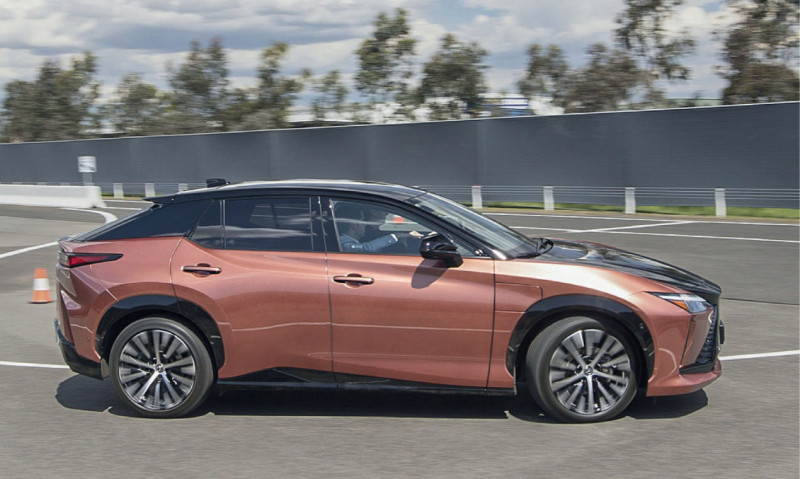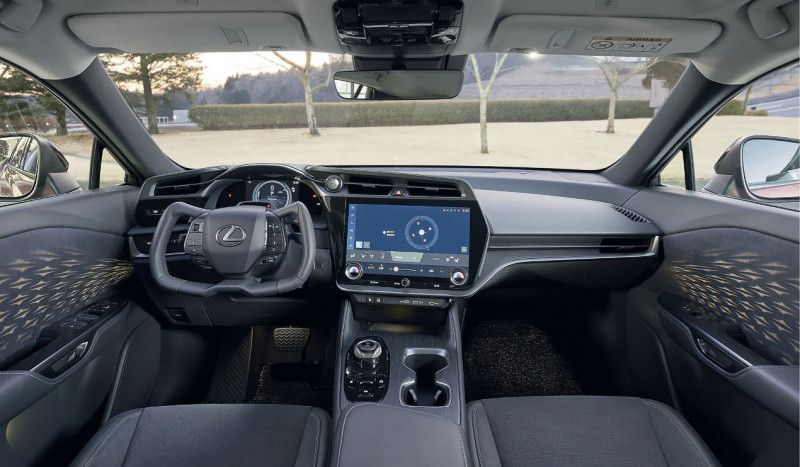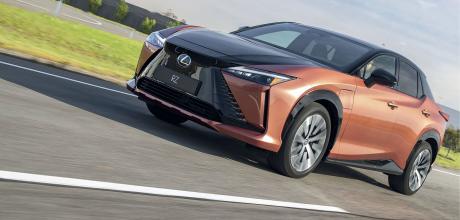2024 Lexus RZ 450e
Electric SUV ditches the steering rack for a by-wire system operated by a yoke. But is it a dynamic turn for the best?
STEER-BY-WIRE TAKES A RADICAL TURN
Electrified Lexus models are nothing new. Thanks to proprietary hybrid technology donated by parent Toyota, the Japanese luxury brand has been offering more frugal versions of its premium models for nearly 20 years. More recently it introduced its first full EV with the arrival of the UX 300e, while the RX 450h plug-in hybrid is also live in other global regions and will join its siblings Down Under. So you’d be forgiven for thinking the new electric RZ 450e is less significant than the electrified models that came before it, but you’d be wrong.


The new addition to the Lexus lineup will be arriving on local shores in the middle of 2023 and when it does, it’ll introduce an AWD, pure battery-powered mid-size SUV with 230kW and about 450Nm, up to 450km of range and space for five adults. Not exactly revolutionary stuff; however, the RZ does pack a few features that will make it stand out.
Manufacturing of the new model hasn’t yet started but, in anticipation of the launch next year, Lexus Australia flew in a pre-production version to offer a first taste of what the RZ 450e has to offer and a chance to experience some of the unique elements that’ll get chins wagging and heads turning.
Firstly, the RZ is not simply a different body rolling on the same chassis and electric bits as the UX 300e. With the donation of Toyota’s e-TNGA platform, the RZ has an entirely different architecture. In fact, the RZ will only be available as an electric model and not alongside petrol or hybrid siblings.
While Lexus’s first EV is limited to front drive, 150kW and about 360km of range, the RZ ups the performance stakes in all areas and is larger overall. More closely related is the forthcoming RX which also uses the e-TNGA platform to introduce a plug-in to the family, if not a full electric version yet.
The bold styling of the RZ certainly ties a strong link to its RX sibling with angular styling that is unapologetic but somehow fluid and flowing.
There are more similarities on the inside with the same 14.0-inch central touchscreen offered for the most premium RX variants, excellent Mark Levinson sound system, seats that manage to be comfortable and ergonomic but sporty and supportive, and other tech touches such as the eLatch door handles.
The family resemblance continues mechanically, too. All-wheel drive is enabled with fully independently controlled eAxles with individual motors, control units and inverter for each end. An overall transmission control program tells which axle to do what but it has almost infinite flexibility with impressive results.
Depending on the circumstances, the RZ can be entirely front-wheel drive or completely rear-drive for either maximum traction and safety or sharpened driving dynamics. In addition, under hard acceleration – the RZ 450e is typically EV swift, hitting 100km/h in about 5.6 seconds – the axles can be controlled to counter tail squat, while under heavy braking the same mechanism helps to almost eliminate dive.
In practice it works very effectively and promotes both a greater sense of stability and confidence as well as providing a more comfortable environment for all on board. The front axle is capable of contributing the most grunt in the system with a 150kW motor versus the 80kW unit at the back, but a full deployment of power feels uniform and deliciously smooth. Until the fully refined production versions arrive mid-2023, a full on-road review will have to wait but a first blast around Toyota’s private test track in Melbourne’s west allowed a tantalising glimpse at what the RZ has to offer.
Its light-filled cabin is classy and the electro-chromatic panoramic roof is a great premium touch, allowing the glass pane to be turned opaque from clear at the press of a button. In its frosted mode, daylight can still permeate but with a gentle softness, but if that’s still too much, a clip-in blind can black the roof out completely.
The RZ is the first Lexus that is completely animal-product free and yet, its plush cabin feels like it isn’t lacking despite the more sustainable materials and upholstery. We’ve said it before and we’ll doubtless say it again, but synthetic ‘leather’ and ‘suede’ alternatives are rapidly reaching a point of quality where they exceed the advantages of genuine cow hides.
Lexus’s staff made a few apologies regarding the pre-production vehicle’s build quality and exact specification but they needn’t. While many handbuilt pre-prods have dubious panel gaps, occasional tatty interior quality and questionable materials, the RZ was a testament to Lexus quality even when it could be forgiven some foibles. Our only qualm is that the fantastic deep-pile, salt-and-pepper-tone floor mats apparently won’t be part of the standard kit.
What will certainly be offered to Australian examples, though, is the RZ’s party piece and, despite our initial suspicions, it isn’t the clumsy gimmick we first feared.
Steering yokes have been wheeled out (pun intended) as part of concept vehicle design studies and production race cars for time immemorial, but when it comes to road cars, the feature nearly always falls by the wayside as nothing more than a stylist’s folly. However, the RZ 450e has a steering yoke and it really works, and it really is going into production.
The difference is in the parts that live behind the unorthodox yoke and steer-by-wire system. Infiniti was the first manufacturer to introduce a steering system that had no mechanical connection between the wheel and the rack but, with a full conventional column waiting to jump in if the system failed, the Infiniti interpretation was a pinkie toe dipped into a sea of potential.
Lexus, on the other hand, has taken the dive.
Like its independent eAxles, the column-less steering brings an unrivalled level of flexibility and versatility, and almost infinitely variable steering parameters.
Variable steering ratio, weight and progressive angle is not a new innovation, but the Lexus system takes all three to a new level. At low speed, it’s possible to turn the front wheels lock to lock in just 150 degrees of yoke rotation (less than one half revolution).
Then, as road speed increases, the ratio lengthens without compromising precision, preventing abrupt inputs that would upset the stability of the car – and the passengers.
Most impressively, though, for a system that has no physical connection to the rubber rolling on the road, there’s an amazing degree of feel and feedback. It’s clear there is something unusual going on beneath the surface, and the overall tactile experience is different but not in an unpleasant or dishonest way.
This is where the Lexus system gets really clever. With a lack of column to send jolts and vibrations back to the cabin, the electronic management is capable of sending only beneficial and welcome sensation through to the driver’s hands.
Long story short, regardless of the vehicle speed, driving situation or corner radius, the driver never has to adjust the position of their hands and, in turn, that means Lexus’s yoke is the first of its kind that actually works. The initial reaction to the steer-by-wire technology is a laser focus on everything that’s happening, but it’s surprising just how quickly the driver adjusts to the system and by the end of our laps of the private track, we need no convincing that this is a feature that needs to stay.
In addition to the dynamic advantages, the absent top crescent of a circular steering wheel offers an unrivalled view of the instruments, while the lack of lower crescent increases leg room under the yoke. The system is a win-win.
Lexus’s venture into more sustainable motoring is gaining momentum and its emerging range of vehicles are demonstrating that lowcarbon, responsible car manufacturing and ownership is about far more than just phasing out petrol power.
With its electric-only line-up, and unique technological and material touches, the RZ is another intriguing step in that direction.
- PLUS Classy, light-filled cabin; strong electric powertrain; innovative steering
- MINUS Steering and dynamics yet to be tested on Aussie roads
RZ 450e is slightly smaller than the forthcoming RX 450h, but there’s still ample room for three adults in the back
Regardless of the corner radius, the driver never has to adjust the position of their hands
TECHNICAL DATA
- Model 2024 Lexus RZ 450e
- Motors Dual (front + rear)
- Max power 230kW
- Max torque 435Nm (estimated)
- Transmission Single-speed reduction gear
- Weight 2296kg
- 0-62mph 0-100km/h 5.6sec (estimated)
- Economy 17kWh/100km (estimated)
- Price $110,000 (estimated)
- On sale H1 2023
Below: Yoke wheel has benefits, but will Lexus customers go for it?


